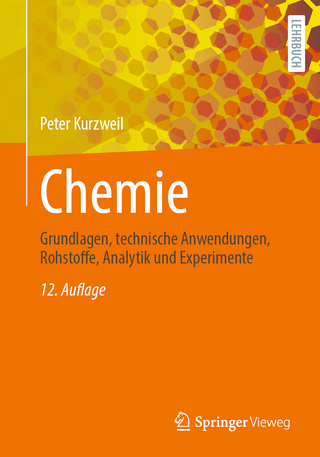
Elements of Chemical Reaction Engineering
Pearson (Verlag)
978-0-13-533755-4 (ISBN)
- Noch nicht erschienen (ca. März 2025)
- Versandkostenfrei innerhalb Deutschlands
- Auch auf Rechnung
- Verfügbarkeit in der Filiale vor Ort prüfen
- Artikel merken
H. Scott Fogler's Elements of Chemical Reaction Engineering, now in its seventh edition, continues to set the standard as the leading textbook in chemical reaction engineering. This edition, coauthored by Bryan R. Goldsmith, Eranda Nikolla, Nirala Singh, still offers Fogler's engaging and active learning experience, with updated content and expanded coverage of electrochemical reactors.
Reflecting current theories and practices, and with a continuing emphasis on safety and sustainability, this edition includes expanded sections on molecular simulation methods, analysis of experimental reactor data, and catalytic reactions.
Leveraging the power of Wolfram, Python, POLYMATH, and MATLAB, students can explore the intricacies of reactions and reactors through realistic simulation experiments. This hands-on approach allows students to clearly understand the practical applications of theoretical concepts.
This book prepares undergraduate students to apply chemical reaction kinetics and physics to the design of chemical reactors. Advanced chapters cover graduate-level topics, including diffusion and reaction models, residence time distribution, and tools to model non-ideal reactors.
The seventh edition includes
An expanded section on molecular simulation methods and potential energy surfaces
Updated examples of experimental reactor data and its analysis
Detailed discussion of definitions in catalysis and examples of catalytic reactions
Additional examples and expanded section on surface reaction mechanisms and microkinetic modeling
A new chapter on electrochemical reactors with example problems, reflecting the growing importance of this field in renewable energy and industrial processes
About the Companion Web Site (umich.edu/~elements/7e/index.html)
Comprehensive PowerPoint slides for lecture notes for chemical reaction engineering classes
Links to additional software, including POLYMATH(TM), MATLAB(TM), Python, Wolfram Mathematica(TM), AspenTech(TM), and COMSOL(TM)
Interactive learning resources linked to each chapter, including Learning Objectives, Summary Notes, Web Modules, Interactive Computer Games, Solved Problems, FAQs, additional homework problems, and links to LearnChemE and other resources
Living Example Problems provide interactive simulations, allowing students to explore the examples and ask "what-if" questions
Professional Reference Shelf, which includes advanced content on reactors, weighted least squares, experimental planning, laboratory reactors, pharmacokinetics, wire gauze reactors, trickle bed reactors, fluidized bed reactors, detailed explanations of key derivations, and more
Problem-solving strategies and insights on creative and critical thinking
H. Scott Fogler was the Ame and Catherine Vennema Professor of Chemical Engineering and the Arthur F. Thurnau Professor at the University of Michigan. He was 2009 President of the American Institute of Chemical Engineers. Fogler chaired ASEE's Chemical Engineering Division, served as director of the American Institute of Chemical Engineers, and earned the Warren K. Lewis Award from AIChE for contributions to chemical engineering education. He received the Chemical Manufacturers Association's National Catalyst Award and the 2010 Malcolm E. Pruitt Award from the Council for Chemical Research. Bryan R. Goldsmith is the Dow Corning Assistant Professor of Chemical Engineering at the University of Michigan, Ann Arbor. He joined Michigan in 2017 after completing a Humboldt Postdoctoral Fellowship at the Fritz Haber Institute of the Max Planck Society in Berlin, Germany. He received his PhD in chemical engineering from the University of California Santa Barbara in 2015. His research lab specializes in atomistic modeling and machine learning to understand and design catalysts for chemical conversion, pollution reduction, and energy generation and storage. He was a recipient of the AIChE 35 under 35 Award and the ACS OpenEye Outstanding Junior Faculty Award. Eranda Nikolla is a professor in the Department of Chemical Engineering at the University of Michigan and is Materials Science Editor of the Journal of Catalysis. She received MS and PhD degrees from the University of Michigan and was a postdoctoral scholar in chemical engineering at the California Institute of Technology from 2009-2011. Her research lab focuses on studying issues related to thermocatalysis and electrocatalysis for energy and chemical conversion and storage. Nirala Singh is an assistant professor of chemical engineering at the University of Michigan. He received a BSE in chemical engineering from the University of Michigan in 2009 and a PhD in chemical engineering from the University of California Santa Barbara in 2015.
Introduction
About the Authors
Chapter 1: Mole Balances
Chapter 2: Conversion and Reactor Sizing
Chapter 3: Rate Laws
Chapter 4: Stoichiometry
Chapter 5: Isothermal Reactor Design: Conversion
Chapter 6: Isothermal Reactor Design: Moles and Molar Flow Rates
Chapter 7: Collection and Analysis of Rate Data
Chapter 8: Multiple Reactions
Chapter 9: Reaction Mechanisms, Pathways, Bioreactions, and Bioreactors
Chapter 10: Catalysis and Catalytic Reactors
Chapter 11: Nonisothermal Reactor Design: The Steady-State Energy Balance and Adiabatic PFR Applications
Chapter 12: Steady-State Nonisothermal Reactor Design: Flow Reactors with Heat Exchange
Chapter 13: Unsteady-State Nonisothermal Reactor Design
Chapter 14: Mass Transfer Limitations in Reacting Systems
Chapter 15: Diffusion and Reaction
Chapter 16: Residence Time Distributions of Chemical Reactors
Chapter 17: Predicting Conversion Directly from the Residence Time Distribution
Chapter 18: Models for Nonideal Reactors
Chapter 19: Electrochemical Reactors
Appendix A: Numerical Techniques
Appendix B: Ideal Gas Constant and Conversion Factors
Appendix C: Thermodynamic Relationships Involving the Equilibrium Constant
Appendix D: Software Packages
Appendix E: Rate-Law Data
Appendix F: Nomenclature
Appendix G: Open-Ended Problems
Appendix H: Use of Computational Chemistry Software Packages
Appendix I: How to Use the CRE Web Resources
Index
| Erscheinungsdatum | 03.09.2024 |
|---|---|
| Reihe/Serie | International Series in the Physical and Chemical Engineering Sciences |
| Sprache | englisch |
| Themenwelt | Naturwissenschaften ► Chemie ► Technische Chemie |
| Technik | |
| ISBN-10 | 0-13-533755-0 / 0135337550 |
| ISBN-13 | 978-0-13-533755-4 / 9780135337554 |
| Zustand | Neuware |
| Informationen gemäß Produktsicherheitsverordnung (GPSR) | |
| Haben Sie eine Frage zum Produkt? |
aus dem Bereich


